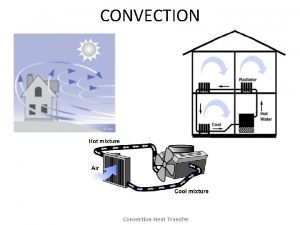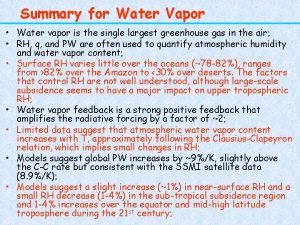Free and Forced Convection over Horizontal Cylinders Justin

- Slides: 1

Free and Forced Convection over Horizontal Cylinders Justin Cournoyer, Ami Humphrey, Cedric Masengere, Chris Reilly Department of Chemical Engineering, University of New Hampshire Introduction Results and Discussion Design Problem Diameter (in) Power (W) Convection Coefficient (W/m 2 K) 1/4 13. 84 38. 56 41. 38 41. 96 3/8 15. 67 38. 10 37. 43 45. 16 1/2 10. 99 28. 16 62. 64 71. 22 A cylindrical heating element is used in an endothermic reaction that takes place in air in a reaction vessel at 30°C. The volume of the vessel is 0. 5 m 3. Heat must be added at a rate of 100 J/min but the temperature of the heating element must not exceed 80°C. Determine the size of the heating element necessary to achieve the design objectives with natural convection. If the reaction medium is flowing through the vessel at a flow rate of 25 m/s, how is the size of the heating element affected? Guess heating element diameter Forced Convection Air Flow (v = 25 m/s) Calculate Reynold’s number 30 20 Nu Use experimental correlation to find Nusselt number Vessel (V = 0. 5 m 3) 25 TS = 80°C 15 Find convection coefficient Heating Rod (q = 100 J/min) 10 5 D Find length of heating element 0 0 4000 8000 Ra. D 12000 16000 L Find surface area of heating element Find dimensions of reactor vessel T∞ = 30°C 150 Nu 120 Constant Variables Forced Convection Diameter Air flow rate Air Flow Voltage Legend 1. Flow meter 2. Air Inlet 3. Power Source 4. Heating Rods 5. Air outlet 6. Thermocouple Reader 7. Voltmeter 8. Ammeter 60 30 2000 1500 1000 500 0 0 Convection Coefficient (W/m 2 K) Manipulated Variables Free Convection Diameter Voltage 90 2500 Heat Transfer Coefficient (W/m 2 K) Methods Heat Transfer Coefficient (W/m 2 K) 180 0, 25 0, 5 Re. D 0, 75 1 0, 002 Rod Diameter (m) 1/4" Diameter 300 3/8" Diameter 200 1/2" Diameter 6, 06 E+06 6, 05 E+06 0, 003 Figure 4. Free convection heat transfer coefficient versus rod diameter. 400 Calculate Rayleigh number 0 0, 001 0, 002 0, 003 Rod Diameter (m) Figure 5. Forced convection heat transfer coefficient versus rod diameter. Free Convection Solution: D = 0. 125 inches and L = 1. 93 inches Forced Convection Solution: D = 0. 047 inches and L= 5. 75 x 10 -5 inches 100 0 0, 2 0, 3 0, 4 0, 5 Velocity (m/s) 0, 6 References C. Geankoplis, Transport Processes and Separation Process Principles, 4 th ed. Pearson Education, Inc. , 2003 Acknowledgements: We would like to thank Dr. St. Jean for aiding in data collection and analysis in this experiment.

